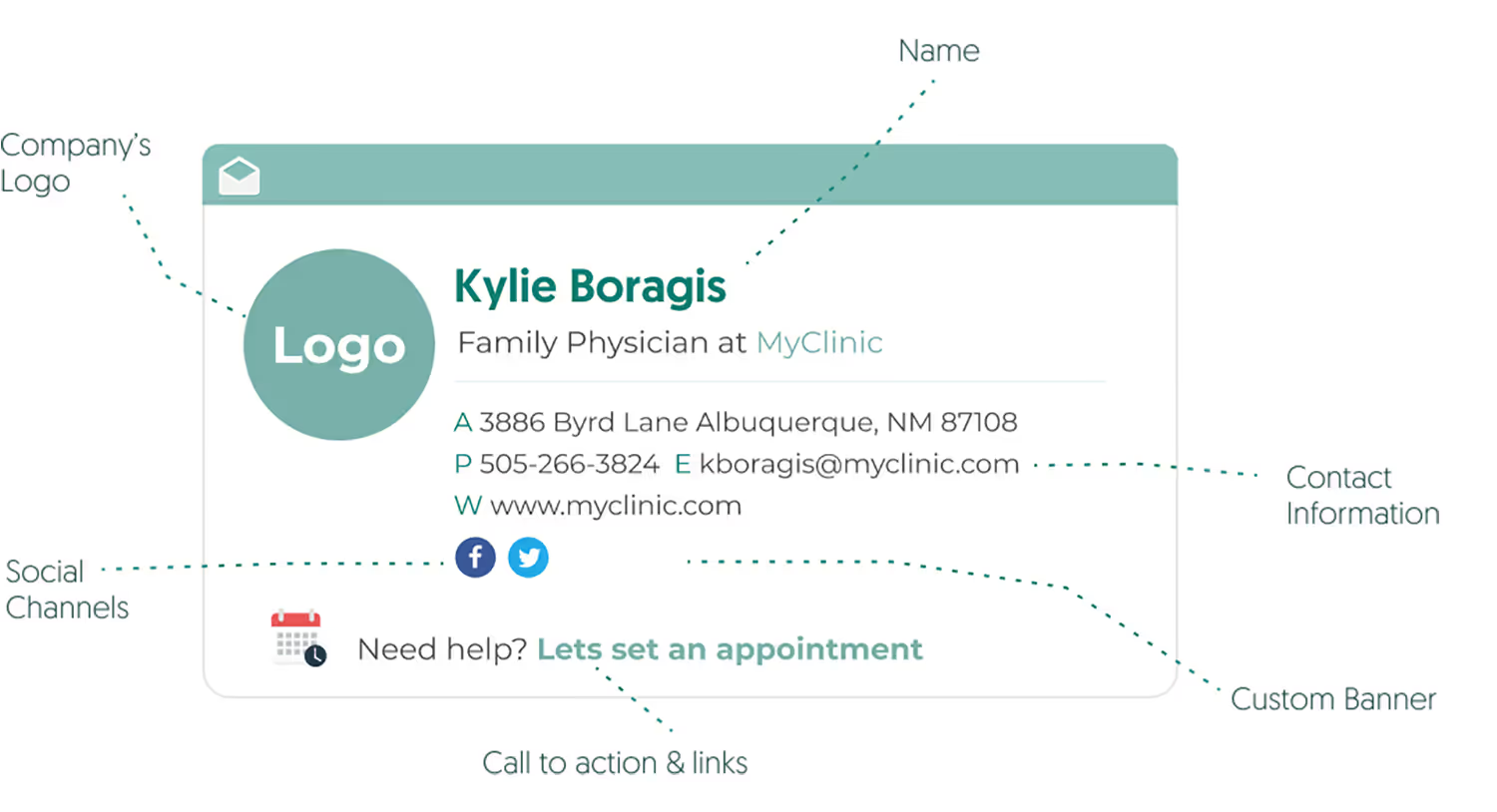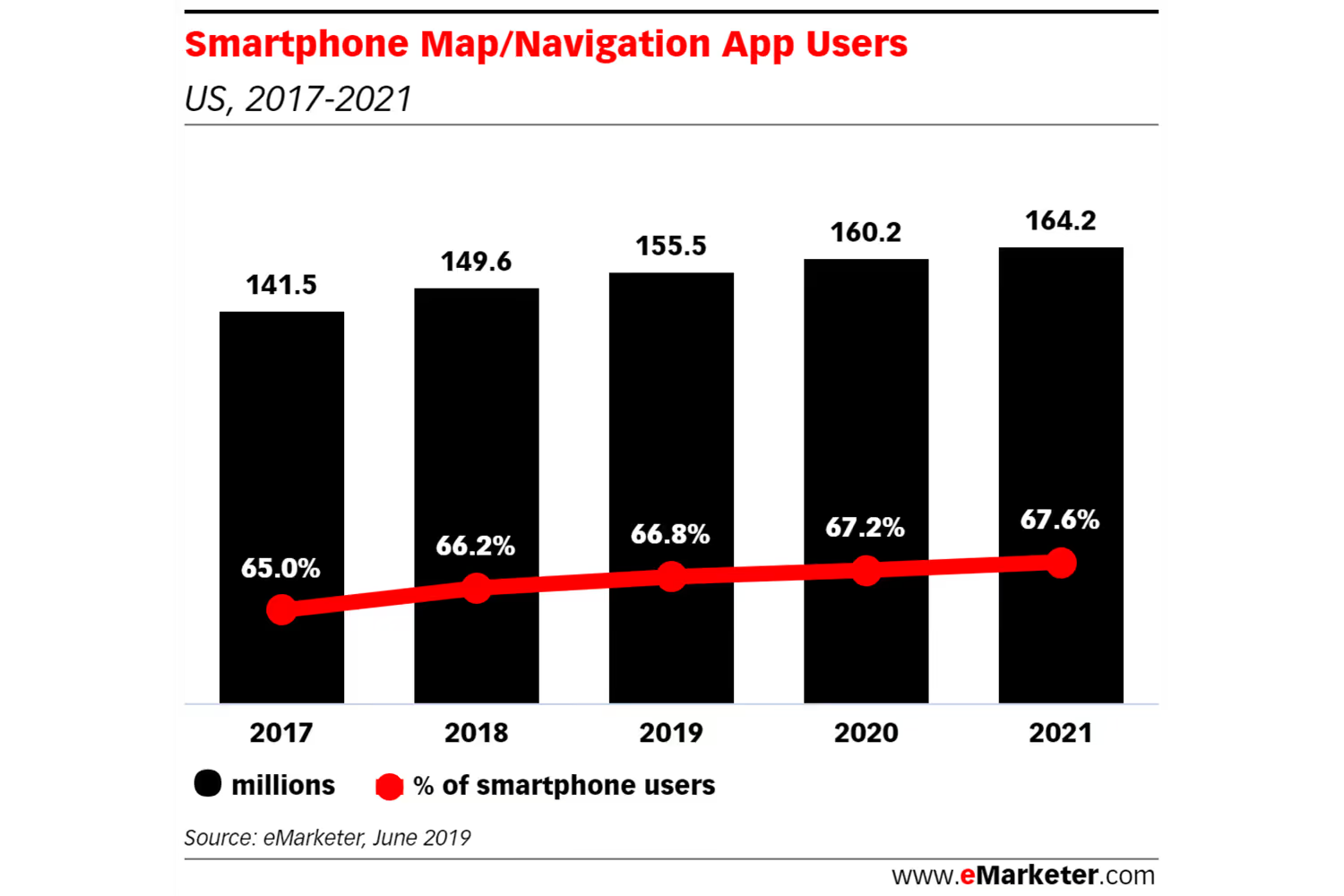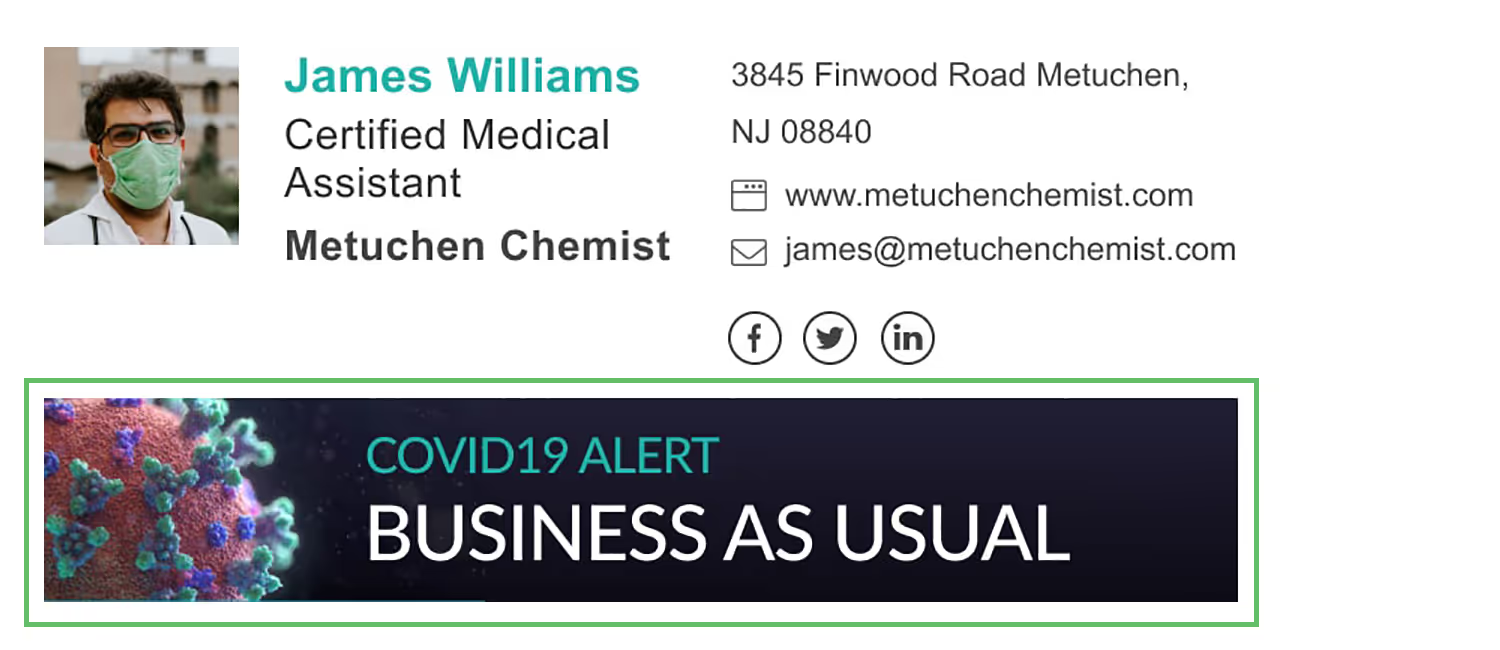Doctor Email Signatures: Why You Need Them (With Examples)
Well, each piece of content within the signature serves a purpose. Here are 7 reasons why you need an email signature.

It’s 2021. Thus, I imagine your practice is taking advantage of doctor-patient email communication. If I’m right in that assumption, you have a lot of details to consider.
Using any form of online messaging within healthcare comes with some necessary policies and guidelines to ensure the safety of data. Some steps also improve how patients engage with your messages.
One important piece that you should always include in emails to your patients is an email signature. This is like a digital business card that contains helpful information about you and your practice.

But what’s the point of using these comprehensive signatures instead of just your name? Your patients will already know who you are if they’re receiving emails from you.
Well, each piece of content within the signature serves a purpose. Here are 7 reasons why you need an email signature.
Introduces You More Personally
It sounds contradictory for your signature to introduce you. At this point, the patient has already read your email. So why introduce yourself after?
Well, the signature includes details about you that would be unnecessary to state in every message. It isn’t meant to be a formal introduction, but briefly mention you who are. This way, the recipients have another way to identify who the email is from.
It gives them information about who you are, such as your position or department. This establishes your credibility about what you’re communicating to them. You can add your practice’s logo and branding so they’ll quickly recognize you.
Or, including a headshot within the signature has the same effect and will help them remember you. Then they’ll also recognize you when they come in for an appointment, even if it’s been a while.

Makes it Easy to Contact
Business cards are convenient because they keep contact information for the company all in one place. They’re easy to store in your wallet so you always have access to the phone number, website, or email that you need.
Email signatures work the same way. It keeps all the necessary contact information in one spot that patients can access any time they go to their inbox. This also ensures they’re using the current number or email address instead of one that’s outdated.
Any time one of these changes, you can state it in the signature that it’s new. That way, recipients stay updated with the contact method they’re using.

It may seem redundant to include your email address within the signature. They’ll already have the email address since you’re sending them a message from it. But most messages will only show the display name, not the address itself. Plus, it gives people a way to double-check that the message isn’t a phishing attempt. I’ll mention more about this later.
Lists Where to Find You
Have you ever looked up a business for directions, but the address on your GPS is different from what’s listed online? Your GPS also may not be clear about which building is your destination when you arrive if there are other businesses nearby.
If this happened to your patients coming in for an appointment, they’d be pretty frustrated by the time they figured out where they needed to be. They don’t want to be so late that their visit gets delayed or rescheduled. And they really won’t want penalization for a no-show.
An estimated 67.6% of smartphone users will use maps and navigation apps in 2021. If your address is wrong within a map app or online, it’s a recipe for your patients getting lost.

But adding your office’s address confirms where the visit is so there’s no guessing whether your clients have the correct location.
It also guides them to your online location if you include your practice’s website. Using a dynamic link makes it even easier for them to access the site instead of needing to type it into their search bar. This is convenient if there are payment or scheduling options on your website, especially if you’re sending an email with a reminder.
Social media icons are another simple option to direct recipients to your online presence. It’s another way for people to find what’s new with your practice and get useful updates fast.
Points to Useful Links
Website and social media platforms aren’t the only links you can include within your company-wide email signature. If you have any events or useful sources, you can add a call-to-action (CTA) button with the link to the source.
These are like button images that you may normally add to the website, but for your email instead. It skips a step so your patients don’t need to visit your page before they see this CTA image.

It’s another way to drive traffic to your website if email recipients don’t already visit it much. Since they’re already patients, they might not feel the need to visit your page often. This is more true if you’re including your including the most important company information in your email signature.
But adding a CTA that links to a relevant page on your site can increase your website’s engagement. Maybe you’re welcoming a new doctor at your practice, include a link to the announcement in your signature section.
Using a CTA button instead of a text link can increase click-through rates by 28%. More people are likely to click these graphics because they stand out over text when skimming a message. So when adding links to your website, event, or helpful source that you want patients to click, using an image button will make them more likely to click it.
In Case of Emergency
It may seem self-explanatory to seek immediate attention in case of emergency. But, as you know, sometimes patients will put off care. Most people don’t want to admit they have a serious health concern. Sometimes they’ll even look for an explanation that makes them feel more confident in avoiding medical attention.
Patients may need a push from you to seek help during an emergency. Always include in your emails who they should contact in that situation. This may be another doctor who is on-call outside of office hours, or simply calling 911.
If you use two-way communication, there may also be times that clients contact you with their health questions. It’s important to use an automated response to acknowledge you received these, but also to remind them when they should seek emergent care if necessary.
They might be waiting for a response from you before they receive care. This could be wasting essential time that they could be receiving necessary treatment. Within your automated response, remind them that they should seek immediate help if it’s an emergency. Instead of waiting for a response from you, direct them to who to contact.

Helps Protect Confidentiality
Email isn’t completely HIPAA secure when communicating with patients. You only have control over what you send. Recipients need reminders about the sensitivity of their data. That way, they don’t send anything private that isn’t secure or download any of their data without protection.
This usually comes in the form of an email disclaimer. These warn recipients about the confidentiality and security of the contents. They follow the other contents of the signature.
Distinguishes You From Hackers
Phishing attempts aren’t uncommon in healthcare because of how valuable health information is to hackers. They’ll try anything to get their hands on this data.
Hackers are getting more creative with their attempts and will mimic professionals to convince people to give up their data. You don’t want patients or employees to fall victim to these attempts.
Sometimes these attempts are obvious, but not always. Including an email signature makes it easiest to recognize legitimate messages from you. If a recipient notices one without this, it will seem out of the ordinary and they’ll be more likely to confirm who it’s from before engaging.
And if the signature lists your email, then recipients can match that with the sender’s address to verify that it is in fact from your practice.
Conclusion
Email signatures may not seem necessary, especially if the recipients are current patients who already know you. But this addition to your messages provides critical information.
Clients may not visit your website often so won’t be likely to see any updates there. But if you’re sending them emails anyway, it’s an easy place to keep the most necessary details that they need about your practice.
This may include contact information or location that they would be looking up online anyway. Or you can link back to helpful resources, your online presence on social media, or any events that clients should know about.
But make sure you don’t forget about patient safety. This goes for both their physical safety and their cybersecurity. Email signatures are another place to remind patients to seek immediate medical attention in case of an emergency. And you can add your HIPAA email disclaimers so patients stay vigilant against leaked data.
Emphasize your product's unique features or benefits to differentiate it from competitors
In nec dictum adipiscing pharetra enim etiam scelerisque dolor purus ipsum egestas cursus vulputate arcu egestas ut eu sed mollis consectetur mattis pharetra curabitur et maecenas in mattis fames consectetur ipsum quis risus mauris aliquam ornare nisl purus at ipsum nulla accumsan consectetur vestibulum suspendisse aliquam condimentum scelerisque lacinia pellentesque vestibulum condimentum turpis ligula pharetra dictum sapien facilisis sapien at sagittis et cursus congue.
- Pharetra curabitur et maecenas in mattis fames consectetur ipsum quis risus.
- Justo urna nisi auctor consequat consectetur dolor lectus blandit.
- Eget egestas volutpat lacinia vestibulum vitae mattis hendrerit.
- Ornare elit odio tellus orci bibendum dictum id sem congue enim amet diam.
Incorporate statistics or specific numbers to highlight the effectiveness or popularity of your offering
Convallis pellentesque ullamcorper sapien sed tristique fermentum proin amet quam tincidunt feugiat vitae neque quisque odio ut pellentesque ac mauris eget lectus. Pretium arcu turpis lacus sapien sit at eu sapien duis magna nunc nibh nam non ut nibh ultrices ultrices elementum egestas enim nisl sed cursus pellentesque sit dignissim enim euismod sit et convallis sed pelis viverra quam at nisl sit pharetra enim nisl nec vestibulum posuere in volutpat sed blandit neque risus.

Use time-sensitive language to encourage immediate action, such as "Limited Time Offer
Feugiat vitae neque quisque odio ut pellentesque ac mauris eget lectus. Pretium arcu turpis lacus sapien sit at eu sapien duis magna nunc nibh nam non ut nibh ultrices ultrices elementum egestas enim nisl sed cursus pellentesque sit dignissim enim euismod sit et convallis sed pelis viverra quam at nisl sit pharetra enim nisl nec vestibulum posuere in volutpat sed blandit neque risus.
- Pharetra curabitur et maecenas in mattis fames consectetur ipsum quis risus.
- Justo urna nisi auctor consequat consectetur dolor lectus blandit.
- Eget egestas volutpat lacinia vestibulum vitae mattis hendrerit.
- Ornare elit odio tellus orci bibendum dictum id sem congue enim amet diam.
Address customer pain points directly by showing how your product solves their problems
Feugiat vitae neque quisque odio ut pellentesque ac mauris eget lectus. Pretium arcu turpis lacus sapien sit at eu sapien duis magna nunc nibh nam non ut nibh ultrices ultrices elementum egestas enim nisl sed cursus pellentesque sit dignissim enim euismod sit et convallis sed pelis viverra quam at nisl sit pharetra enim nisl nec vestibulum posuere in volutpat sed blandit neque risus.
Vel etiam vel amet aenean eget in habitasse nunc duis tellus sem turpis risus aliquam ac volutpat tellus eu faucibus ullamcorper.
Tailor titles to your ideal customer segment using phrases like "Designed for Busy Professionals
Sed pretium id nibh id sit felis vitae volutpat volutpat adipiscing at sodales neque lectus mi phasellus commodo at elit suspendisse ornare faucibus lectus purus viverra in nec aliquet commodo et sed sed nisi tempor mi pellentesque arcu viverra pretium duis enim vulputate dignissim etiam ultrices vitae neque urna proin nibh diam turpis augue lacus.


.avif)

